 |
 |
 |
| |
Increased Risk of Serious non-AIDS defining Events and Mortality among Immunological Non-Responders to Antiretroviral Therapy
|
| |
| |
Reported by Jules Levin
IAC 2012
Giuseppe Lapadula1, Liliane Chateneaud2, Carlo Torti3,
Simona Di Giambenedetto4, Franco Maggiolo5, Alfredo Scalzini6,
Nicoletta Ladisa7, Laura Sighinolfi8,Massimo Di Pietro9,
Angelo Pan10, Andrea Gori1 for the MASTER Cohort
1 AO "San Gerardo de' Tintori", Monza (MB); 2 "Mario Negri" Institute for Pharmacological Research, Milan; 3 University "Magna Graecia", Catanzaro; 4 "Sacro Cuore" Catholic University of Rome; 5 Ospedali Riuniti, Bergamo; 6 Spedali Civili, Brescia; 7 Ospedale Policlinico, Bari; 8 Ospedale Sant'Anna, Ferrara; 9 Ospedale S.M. Annunziata, Florence; 10 Istituti Ospitalieri, Cremona, Italy
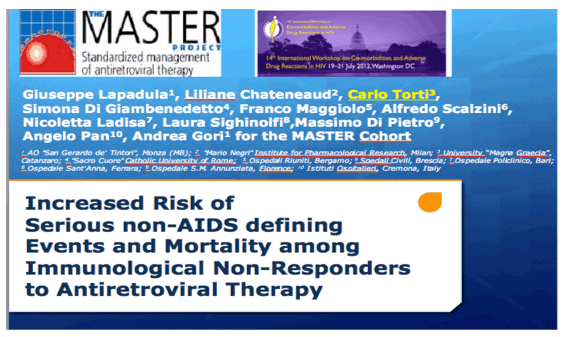
Increased risk of serious non-AIDS defining events and mortality among immunological nonresponders
to antiretroviral therapy in the Italian MASTER cohort
G Lapadula1, L Chateneaud2, A Gori1, C Torti3, S Di Giambenedetto4, F Maggiolo5, A Scalzini6,
N Ladisa7, L Sighinolfi8, M Di Pietro9, A Pan10, G Carosi3, the MASTER Cohort
1Clinic of Infectious Diseases, AO 'San Gerardo de' Tintori', Monza (MB), Italy; 2'Mario Negri' Institute for Pharmacological
Research, Milan, Italy; 3Clinic for Infectious and Tropical Diseases, University of Brescia, Brescia, Italy; 4Clinic of Infectious Diseases,
'Sacro Cuore' Catholic University of Rome, Rome, Italy; 5Clinic of Infectious Diseases, Ospedali Riuniti, Bergamo, Italy; 6Division
of Infectious Diseases, Spedali Civili, Brescia, Italy; 7Clinic of Infectious Diseases, Ospedale Policlinico, Bari, Italy; 8Clinic of
Infectious Diseases, Ospedale Sant'Anna, Ferrara, Italy; 9Clinic of Infectious Diseases, Ospedale S.M. Annunziata, Florence, Italy;
10Clinic of Infectious Diseases, Istituti Ospitalieri, Cremona, Italy
PROGRAM ABSTRACT
Background: Immunological non-response (INR) despite virological suppression has been associated with AIDS-related events (ADE) or death. Little is known about its association with serious non-AIDS-defining events (nADE).
Methods: Patients initiating first HAART with <200 CD4+/μl were enrolled if they had confirmed viral load <50 copies/ml within 15 months of treatment and were categorized as INR if CD4+ at year 1 were <200/μl. The outcome of interest was time to nADE (malignancies, severe infections, renal failure [that is, eGFR<30],
cardiovascular events, liver decompensation, acute pancreatitis, non-AIDS related death). Predictors of nADE were assessed using univariable and multivariable Cox models. Follow-up was right-censored in case of cART discontinuation, viral load >50 for ≥180 days or AIDS-related death.
Results: A total of 1,229 patients (75.3% male, 16.7% intravenous drug users [IVDU]) were observed over a mean follow-up of 3.9 (±3.1) years. Pre-HAART CD4+
was 87 (±62)/μl and 55.2% of patients had experienced an ADE. After 1 year, CD4+ increased to 318 (±177), but 26% of patients were INR. Thereafter, 102 nADE (24.5% malignancies, 20.6% infectious, 18.6% renal, 15.7% cardiovascular, 8.8% hepatic, 5.8% other non-fatal, 5.8% deaths due to other non-AIDS-related causes) and 70 ADE were observed. The incidence of nADE was 2.13 (95%CI 1.76, 2.58) per 100 PYFU. INR had significantly higher risk of nADE (HR 1.80 [95%CI 1.20, 2.68]; P=0.004). Older age (per year, HR 1.03 [1.01, 1.05]; P=0.008), IVDU (HR 1.55 [1.00, 2.41]; P=0.050) and hepatitis coinfection (HR 1.49 [0.92, 2.43]; P=0.103) were also associated with nADE. After adjusting for baseline characteristics, INR remained independently associated with nADE (HR 1.61 [1.07, 2.43]; P=0.023). The occurrence of ADE during the follow-up increased the risk of nADE (HR 3.49 [1.99, 6.12]; P<0.001). A separate model adjusted for ADE as time-varying covariate confirmed the association between INR and the outcome (HR 1.67 [1.12, 2.51]; P=0.012).
Conclusions: Immunological non-responders run a greater risk of serious nADE. Improved management of this fragile population and innovative immune therapies are urgently needed.
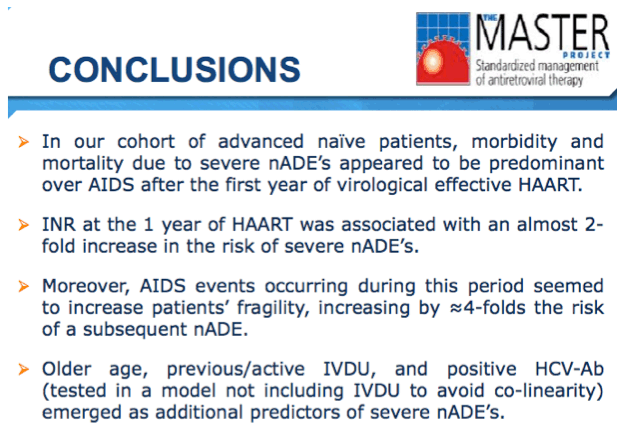

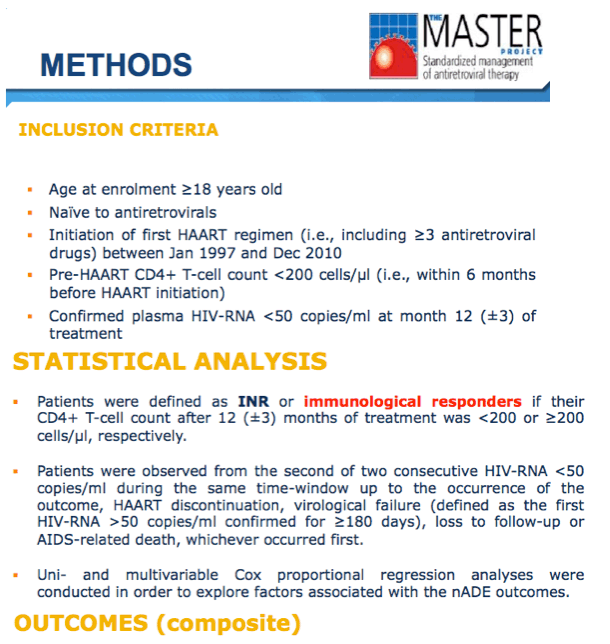
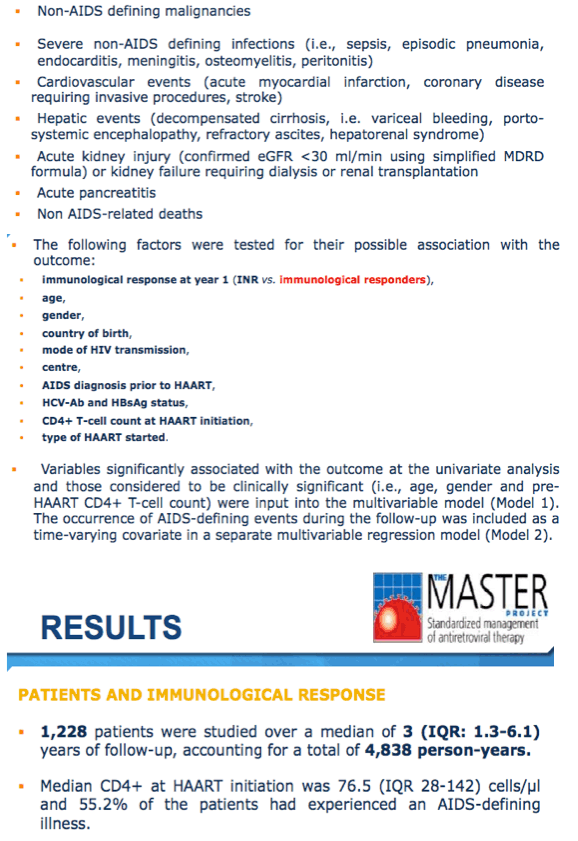
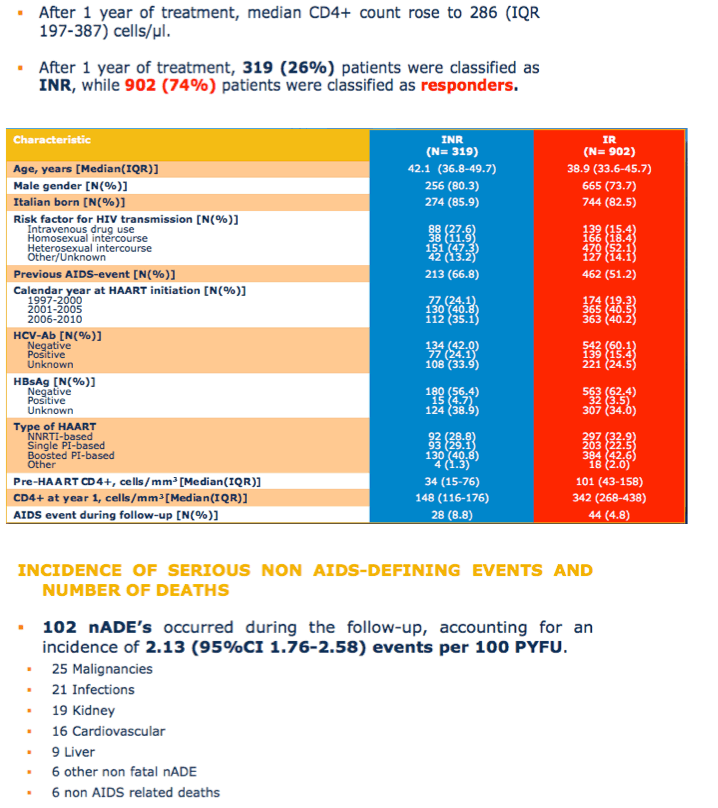
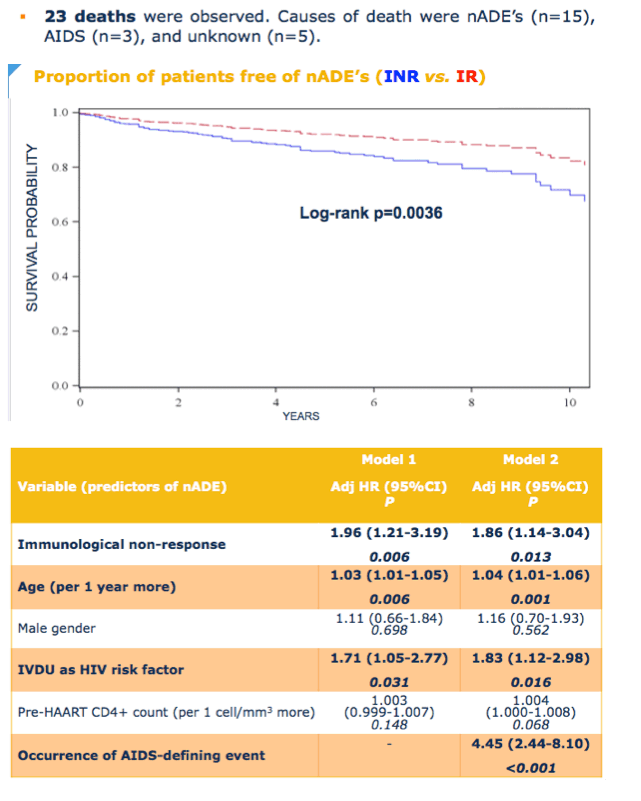
|
| |
|
 |
 |
|
|